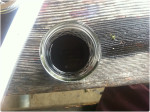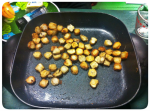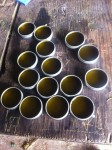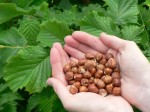Syrups are a wonderful way to take herbal medicine. They are satisfyingly sweet, with honey (most common), or other substitutes such as sugar, maple syrup, or vegetable glycerin combined with concentrated herbal extracts. Good for both children and adults, syrups are used to treat a variety of symptoms and ailments such as colds, flu and seasonal allergies. Syrups can also be taken for physical and emotional well-being, such as for strengthening the immune system, relieving tension and stress, mood changes, and much more.
What is a Syrup?
An herbal syrup is a blended, concentrated form of herbal extract and honey.
Syrups are usually a pleasing balance between medicinal and aromatic herbs — if the medicinal herb has a strong or bitter (or otherwise unpleasant) taste, an aromatic herb can be added in for flavor (and for their medicinal benefits, as many aromatic herbs have their own special properties).
* Note * : as always, do your research or consult with your naturopathic physician before attempting to treat chronic illness, disease, if you take pharmaceuticals, or if you are pregnant / nursing.
Honey is used in a syrup for a few reasons: first, it is an excellent preservative; and second, honey is amazing natural medicine! It’s anti-inflammatory, antibacterial and nutritious for our bodies. Honey has been used for centuries as an herbal remedy, and it contains many vitamins, minerals, amino acids, and living enzymes that are deeply beneficial for our bodies. However, to receive these wonderful nutritive aspects, we need to use raw (unpasteurized) honey, especially honey from our own specific region. Pasteurizing honey kills off the beneficial probiotics and enzymes, and messes with many of the proteins that give honey its medicinal qualities.
Local honey is an excellent remedy, or tonic, for seasonal allergies. Taken long-term (a few tablespoons every day), it helps to strengthen our immune systems. Local honey contains varying amounts of the pollen found in your region, and this helps ‘desensitize’ the body to the allergen. If you are interested, click here to read a scientific study on using honey to relieve allergy symptoms.
Ideas for Herbal Syrups
Depending on what you would like to use your syrup for, there are many, many options. Here are some ideas/ suggestions!
- Elderberry Syrup for Cold/Flu + Immune Booster
- Honey & Onion Syrup for Colds
- Thyme Syrup for Coughs & Chest Colds
- Red Clover-Violet Syrup for Lymphatic Congestion
- Mullein & Honey Cough Syrup
Ingredients for an Herbal Syrup
- 2 oz of Herb Mixture
- 1 Quart Water
- 1 cup Raw, Organic, and Local Honey
Directions for Making an Herbal Syrup:
In a pot over low heat, combine the herb mixture and water. Simmer the liquid down to 1 pint of water (roughly half the amount of the original water). This creates a very concentrated tea.
Next, using a cheesecloth, jelly strainer bag, or metal strainer, strain the herbs from the liquid. Reserve the herbs (they can now be composted), and pour the liquid back into the pot.
Now, add 1 cup of honey (or other natural sweetener substitute, such as maple syrup, vegetable glycerin, brown sugar). A good rule of thumb is that for every pint (1 pint = 2 cups) of concentrated liquid, add 1 cup of sweetener.
In the pot, warm the honey and liquid together only enough to combine fully. Some recipes instruct you to cook the honey and liquid together over high heat for 10-30 minutes to thicken it up, but, as Rosemary Gladstar notes, this can cook the living enzymes of out the honey.
Once the syrup is fully combined, you have the choice of adding in 1-2 drops of essential oils ( *note: do some research on the amount of your EO to use!), or a small amount of brandy to help preserve the syrup and to act as a relaxant in cough syrups.
Now, remove from heat and bottle. Be sure to label with name, date, ingredients, and purpose! The syrup will last for several weeks if refrigerated.
Dosage Information:
This recipe for a syrup can be enjoyed throughout the day — 1 teaspoon every hour or every couple of hours for an adult, depending on the herbs used.
Recommended Resources:
- Rosemary Gladstar’s Herbal Recipes for Vibrant Health
- Rosemary Gladstar’s Medicinal Herbs
- Rosemary Gladstar’s Herbs for Natural Beauty
Learn how to confidently identify plants using their unique family patterns in this in-depth video by author of Botany in a Day, Thomas Elpel!
*** For educational purposes only. This information has not been evaluated by the Food and Drug Administration. This information is not intended to diagnose, treat, cure or prevent any disease. We recommend that you consult with a qualified health care practitioner before using herbal products, particularly if you are pregnant, nursing or on any medications. ***
*** Please read our Honorable Harvesting Guidelines before harvesting any plant material. The final guideline is of utmost importance: “Never put anything in your mouth unless you are 100% sure it is safe to ingest.” ***
 Hannah began her apprenticeship at Wolf Camp in 2013 and graduated as a lead herbal instructor in 2014. Join Hannah and other Wolf College wild chefs during our annual Wild Cooking & Ethnobotany Expedition: The Herbal Foray the second week of July on Lake Sammamish near Seattle.
Hannah began her apprenticeship at Wolf Camp in 2013 and graduated as a lead herbal instructor in 2014. Join Hannah and other Wolf College wild chefs during our annual Wild Cooking & Ethnobotany Expedition: The Herbal Foray the second week of July on Lake Sammamish near Seattle.
Hannah graduated from the University of Oregon in 2014 with a Bachelor’s Degree in Foreign Languages. She has her own blog, where she writes about her love for crafts, animals, plants, cooking, and the outdoors: rainmountaincrafts.com












